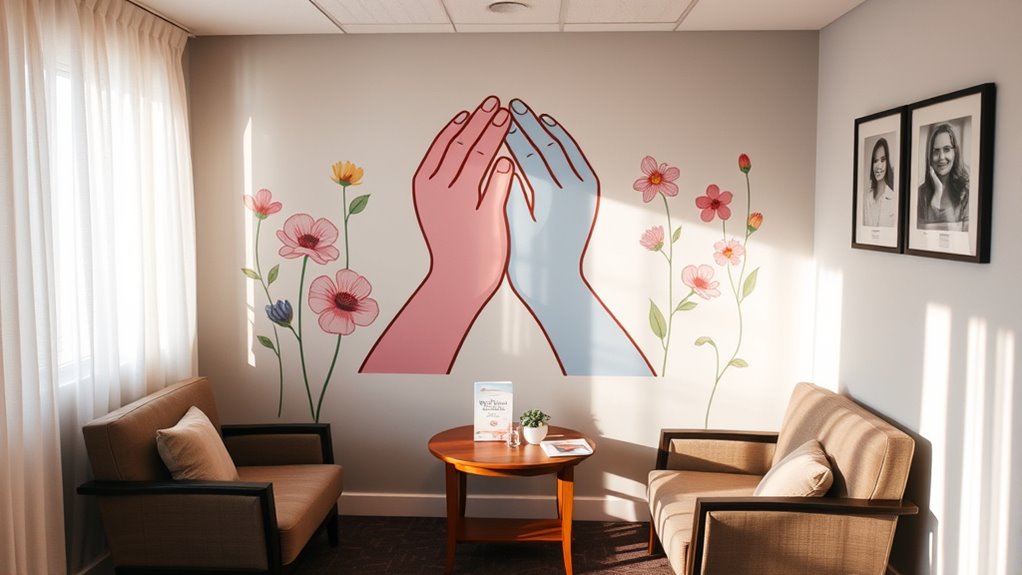If you’re leaving an abusive marriage, it’s vital to access resources that prioritize your safety. Hotlines like The Hotline offer immediate support, while shelters and community programs provide temporary housing. Healthcare providers can connect you to advocacy services and legal options like restraining orders. Creating a safety plan is essential to protect yourself and your children during this important time. By exploring these options, you’ll find ways to stay safe and gain the support you need—more guidance awaits as you continue forward.
Key Takeaways
- Contact crisis hotlines like The Hotline for immediate support and safety planning assistance.
- Seek shelter at domestic violence shelters or community programs for safe housing options.
- Work with healthcare providers to access legal aid, counseling, and protective services.
- Develop a safety plan that includes exit strategies, emergency contacts, and escape routes.
- Obtain legal protections such as restraining orders and custody arrangements to enhance safety.

Are you or someone you know experiencing domestic violence? If so, it’s essential to recognize that help is available, and you don’t have to face this alone. Domestic abuse affects a considerable portion of the population—about 12 million Americans each year—and it’s a serious issue that can escalate, especially during times of separation. Knowing where to turn for support can make a critical difference in ensuring your safety and well-being.
Many victims find it challenging to leave because abusers often isolate them from friends, family, and support networks. They might monitor your communications or restrict your contact with others, making you feel alone and helpless. Fear for your safety and your children’s safety is another major barrier. Threats of harm, including actual abuse or even murder, are common, especially during or after separation. It’s important to understand that these threats are serious and that help is available to protect you and your children.
Abusers often isolate victims, making escape and seeking help extremely difficult and dangerous.
Legal protections like restraining orders and supervised visitation can provide safety boundaries, but many victims worry about losing custody or being unable to shield their children. Abusers may use custody disputes as a weapon to continue controlling you, which can discourage victims from leaving altogether. Cultural, racial, or disability-related obstacles can also make accessing justice and resources more difficult, further complicating the decision to escape an abusive situation.
The most dangerous time for a survivor is often during and immediately after leaving. Violence can escalate, and in some cases, victims defend themselves physically during separation. Wealthy, famous, or influential batterers may use intimidation or legal pressure to maintain control. Because of these risks, having a safety plan and access to support services is essential.
Support networks like hotlines, shelters, and advocacy organizations play a critical role in helping victims navigate these challenges. Crisis hotlines, such as The Hotline, provide immediate intervention and safety planning. Shelters and community programs offer temporary housing, while healthcare providers can connect you to resources and interventions that increase your chances of safely leaving. Studies show that interventions—like advocacy, shelter, and restraining orders—can double the likelihood of a victim successfully escaping abuse, and disclosing abuse to a healthcare provider can greatly improve access to these services. Research indicates that approximately 23–25% of U.S. divorces cite domestic violence or abuse as a significant reason, highlighting the scale of this issue and the importance of accessible resources. In addition, knowing about support services ahead of time can empower victims to take the necessary steps toward safety.
Frequently Asked Questions
How Can I Find Legal Assistance During Separation?
You can find legal assistance during separation by reaching out to local legal aid organizations like Legal Aid of North Carolina or Pisgah Legal Services. Call their helplines or visit their websites to access free or low-cost legal help with protective orders, custody, divorce, or housing issues. Also, check with local shelters or Family Justice Centers, which often partner with legal aid groups to provide trauma-informed support.
Are There Financial Resources for Those Leaving an Abusive Marriage?
Think of a safety net woven with financial resources—yes, there are plenty for you leaving an abusive marriage. You can access grants, emergency funds, and government programs that cover medical bills, housing, and legal aid. Nonprofits and local agencies also offer financial assistance and debt relief. By applying with your documentation, you’re taking essential steps to rebuild your independence, ensuring you’re supported every step of the way toward a safer, stable future.
What Safety Planning Steps Should I Take Before Leaving?
Before leaving, you should develop two escape plans—one for a planned departure and another for emergencies. Choose a safe destination ahead of time, and practice both routes. Arrange transportation, like keeping coins for payphones or a full tank in your car. Inform trusted neighbors or landlords about your plans, and keep important documents, cash, and essentials packed and hidden in a secure “go bag” for quick escape.
How Do I Access Temporary Housing or Shelters?
Getting into temporary housing is like finding a safe harbor in a storm. You should contact the city’s HRA or DHS, which manage emergency shelters, and ask about available options. Use the streamlined admission process if possible, and consider rental assistance programs like Section 8 or FHEPS to shift into permanent housing. Remember, reaching out quickly increases your chances of finding a secure place to stay.
Can I Get Counseling for Children Affected by Domestic Violence?
Yes, you can get counseling for children affected by domestic violence. Many organizations offer age-appropriate group sessions, child-parent psychotherapy, and tailored assessments to help children process their experiences. Reach out to local domestic violence shelters, community mental health agencies, or school counselors to find these services. Early intervention is vital, so don’t hesitate to seek support, as it can considerably improve your child’s emotional and behavioral well-being.
Conclusion
Remember, you’re not alone in this journey. These resources are your lifeline, guiding you safely through the storm. Reaching out might feel like stepping into the unknown, but it’s the first step toward reclaiming your strength and independence. Like a lighthouse guiding a ship to shore, these tools can lead you to brighter days ahead. Trust in their light—you deserve safety, peace, and a new beginning.









